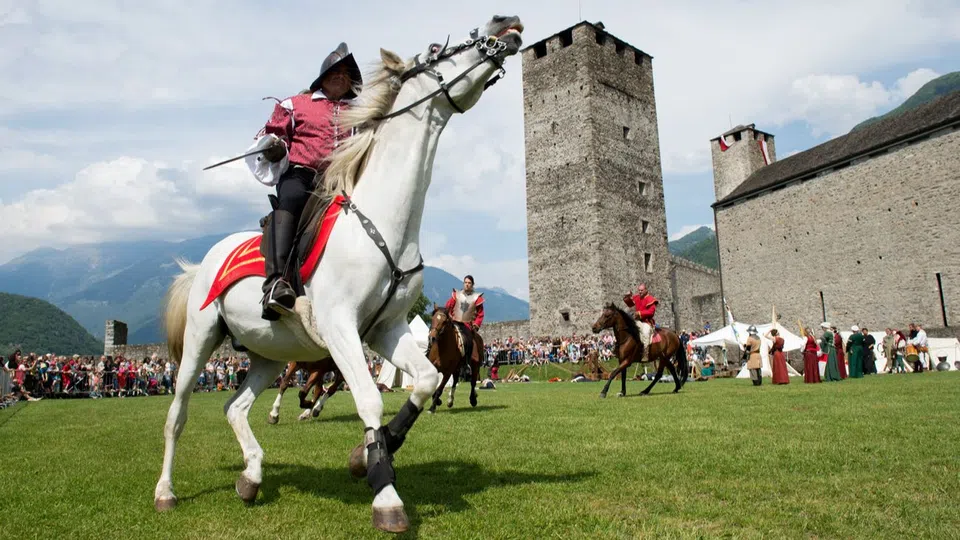The Gugler Invasion Of 1375: The Mystery Of The Vanished Villages
-
Deutsch
de
Gugler-Einfall 1375: Das Rätsel der verschwundenen Dörfer
Original
Read more: Gugler-Einfall 1375: Das Rätsel der verschwundenen Dörfe
Français
fr
L'invasion des Gugler en 1375: l'énigme des villages disparus
Read more: L'invasion des Gugler en 1375: l'énigme des villages disparu
Italiano
it
L'invasione dei Gugler del 1375
Read more: L'invasione dei Gugler del 137
In 1375, a troop of mercenaries known as the Gugler crossed into Switzerland from France. The fighters entered via the Jura and rampaged between the River Limmat and Lake Neuchâtel. Several villages disappeared from the map, although historians dispute how many were destroyed directly by the Gugler.
The mercenaries did not come by chance. The invasion occurred during the Hundred Years' War, when frequent ceasefires left many soldiers without employment. To prevent unrest, the French crown kept them occupied.“So the king kept them busy,” explains Paul Bühler, a theologian and amateur historian from Biberist, canton Solothurn, who has studied the Gugler in detail.
At the time, the French count Ingelram de Coucy (1339–1397) commanded the mercenaries. He sought to claim an inheritance that his mother, Katharina von Habsburg, had never received. Katharina was supposed to inherit several towns – including Aarau, Lenzburg, Bremgarten (canton Aargau), Sursee and Willisau (canton Lucerne) – but she lost them in an inheritance dispute.
Relevant and up to date: the SWIplus app brings you the most important information and news from Switzerland. Download it now !
In December 1375, the mercenaries set out to seize what Ingelram considered his rightful due. They plundered and set fires. To deny them a stronghold, the Habsburgs themselves burned the town of Lenzburg.
The attack by the Bernese on Fraubrunnen Abbey in December 1375. The Guglians have entrenched themselves in the abbey. The illustration dates from 1485, from Diebold Schilling's Spiez Chronicle. Wikimedia Commons/Excommunicato/Uni Fribourg
The campaign lasted about a month before Swiss forces drove the Gugler back to France.
Defeat near ButtisholzThe decisive blow came at Christmas 1375, when troops from Entlebuch defeated the Gugler near Buttisholz. In the following days, they also suffered defeats at the hands of forces from Bern near Fraubrunnen and by troops from Seeland and Fribourg near Ins. A monument in Fraubrunnen still commemorates the victory.
The monument in Fraubrunnen, left, commemorates the Bernese who fell in battle against the Gugler in 1375. Wikimedia Commons/Alfred Weyeneth
Although the Gugler were expelled, the damage was severe.“In their search for food and warmth, the mercenaries robbed villages and set fire to farmhouses,” says Bühler.
Vanished villagesNumerous settlements disappeared during this period. In canton Solothurn, examples include the towns of Altreu and Fridau, or villages such as Waldkirch and Bienken near Oensingen, Wedelswil and Gutzwil near Solothurn, Bützingen near Lüsslingen, and Günnikofen near Lüterkofen.
This is what Altreu might have looked like around 1300. The small town with the bridge over the Aare (white) has disappeared, today Altreu is a small village. zvg/Kantonsarchäologie Solothurn.
But were the Gugler truly responsible? Bühler notes that“the plague and economic difficulties also contributed to the decline of villages”. Some may have been abandoned before the invasion.
Even today, the evidence remains uncertain. Estimates of the invading force vary widely, ranging from fewer than 20,000 to as many as 40,000 men. The cantonal archaeology department of Solothurn, for example, describes the vanished town of Altreu:“There is archaeological evidence of a fire disaster here. Whether the town fire can be blamed on the Gugler remains an open question.”
Lenzburg Castle still towers over the small town today. This is where the Habsburgs retreated to when the Gugler ravaged the Central Plateau. Keystone/Gaetan Bally
Not every vanished village can therefore be attributed to the mercenaries. But 650 years ago, the Gugler certainly left a trail of destruction on the Swiss Plateau.
Theologian, pastor and amateur historian Paul Bühler has studied the Gugler in depth and is giving lectures on the 650th anniversary of the invasion. SRF/Marco Jaggi
Wikimedia Commons/Pharos/Metropolitan Museum of Art Where does the name Gugler come from?
Gugler comes from the Middle High German word Gugel. In the 14th century, this was a type of cap, a hood, which the Gugler wore under their helmets. The word is probably also found in the famous cake, the Gugel-Hopf, as the baking tin is reminiscent of the Gugel.
Translated from German using DeepL/amva/ts
Popular Stories More Global elections Does democracy really make the world more peaceful? Read more: Does democracy really make the world more peaceful
Legal Disclaimer:
MENAFN provides the
information “as is” without warranty of any kind. We do not accept
any responsibility or liability for the accuracy, content, images,
videos, licenses, completeness, legality, or reliability of the information
contained in this article. If you have any complaints or copyright
issues related to this article, kindly contact the provider above.
Most popular stories
Market Research

- Kintsu Launches Shype On Hyperliquid
- Barunson, Studio Behind Parasite, To Launch Nplug IP Remixing Platform On Story And Bring Flagship IP Onchain
- Moonbirds And Azuki IP Coming To Verse8 As AI-Native Game Platform Integrates With Story
- Leverage Shares Launches First 3X Single-Stock Etps On HOOD, HIMS, UNH And Others
- Alchemy Markets Launches Tradingview Integration For Direct Chart-Based Trading
- Dexari Unveils $1M Cash Prize Trading Competition






















Comments
No comment